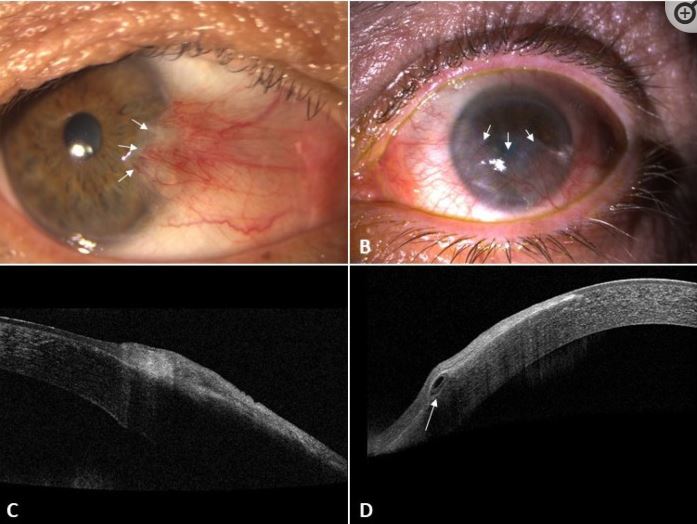Pseudopterygium is a common eye condition that can affect anyone, regardless of age or gender. It is a growth of tissue that extends from the conjunctiva over the cornea, which can cause discomfort, redness, and visual disturbances. If left untreated, pseudopterygium can lead to serious complications, including permanent vision loss.
Pseudopterygium is a non-progressive conjunctival adhesion to the peripheral cornea secondary to corneal-limbus damage. It is caused by the invasion of the subconjunctival tissue into the cornea, which can result from various factors, including trauma, infection, or inflammation. Pseudopterygium is often confused with pterygium, which is a similar growth of tissue that extends from the conjunctiva to the cornea.
Difference between Pterygium and Pseudopterygium
- Pterygium attaches to the limbus whereas pseudopterygium does not adhere to the limbus. This is, there is no plane of cleavage between the lesion and corneal epithelium but in pseudopterygium is an overgrowing membrane that is not attached to the underlying cornea and there is a real plane of cleavage between it and the corneal epithelium (as demonstrated in the image below).
- Pterygium usually appears nasally or temporally but pseudopterygium can appear everywhere including oblique appearance.

Treatment Options for Pseudopterygium
There are various treatment options for this condition, depending on the severity and location of the growth.
Non-surgical treatments can include eye drops and lubricants, steroid eye drops, and anti-inflammatory medications. These treatments can help relieve symptoms and reduce inflammation, but they may not be effective for larger or more severe pseudopterygia.
Surgical treatments for pseudopterygium can include conjunctival autograft surgery, amniotic membrane transplantation, excision surgery, and radiotherapy. These treatments are typically more effective for larger or more severe pseudopterygia, and they can help prevent the recurrence of the growth.
- Conjunctival autograft surgery involves removing a piece of healthy tissue from the conjunctiva and grafting it onto the cornea to cover the pseudopterygium. This procedure is effective for reducing symptoms and preventing the recurrence of the growth.
- Amniotic membrane transplantation involves placing a piece of amniotic membrane onto the cornea to promote healing and reduce inflammation. This procedure is effective for reducing symptoms and preventing the recurrence of the growth.
- Excision surgery involves removing the pseudopterygium and any affected tissue from the cornea. This procedure is effective for reducing symptoms and preventing the recurrence of the growth, but it can also be more invasive and may require a longer recovery time.
- Radiotherapy involves using high-energy radiation to kill the cells that are causing the pseudopterygium. This procedure is effective for reducing symptoms and preventing the recurrence of the growth, but it can also have side effects and may require multiple treatments.
Recovery and Aftercare
After undergoing treatment for pseudopterygium, it is important to follow the eye doctor’s instructions for pre-operative and post-operative care. This can include taking medications as prescribed, using eye drops, and avoiding activities that can strain the eyes.
Possible complications of pseudopterygium surgery can include infection, bleeding, and scarring. It is important to attend follow-up visits with the eye doctor to monitor for any signs of complications and ensure proper healing.
Prevention and Lifestyle Changes
Various tips and lifestyle changes can help prevent pseudopterygium and maintain good eye health. These can include wearing protective eyewear, avoiding prolonged exposure to sunlight, maintaining a healthy diet, and avoiding smoking.
In addition, it is important to practice good eye hygiene, such as washing your hands before touching your eyes, avoiding rubbing your eyes, and avoiding sharing eye makeup or contact lenses with others.
Conclusion
Pseudopterygium is a common eye condition that can cause discomfort, redness, and vision disturbances. If left untreated, it can lead to serious complications, including permanent vision loss. However, with early detection and proper treatment, pseudopterygium can be effectively managed and prevented from recurring.
By following the tips and lifestyle changes outlined in this blog, you can help maintain good eye health and prevent pseudopterygium from occurring. Remember to practice good eye hygiene, wear protective eyewear, and seek medical attention if you experience any symptoms of pseudopterygium.
References
- Urbinati, F., Borroni, D., Sánchez-González, M., García-Lorente, M., Zamorano-Martín, F., Rachwani-Anil, R., Ortiz-Pérez, S., & Romano, V. (2022). Pseudopterygium: An Algorithm Approach Based on the Current Evidence. Diagnostics, 12(8). https://doi.org/10.3390/diagnostics12081843
- Le Q., Xu J., Deng S.X. The diagnosis of limbal stem cell deficiency. Ocul. Surf. 2018;16:58–69.
- Soliman W., Mohamed T.A. Spectral domain anterior segment optical coherence tomography assessment of pterygium and pinguecula. Acta Ophthalmol. 2012;90:461–465




